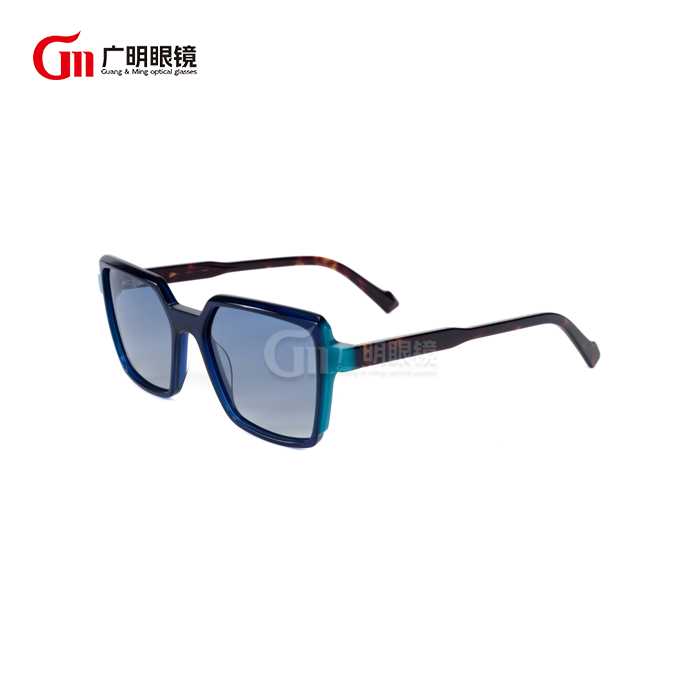How to adjust hexagon tortoise sunglasses for a snug fit?
Achieving the perfect fit with hexagon tortoise sunglasses requires understanding both the unique characteristics of their geometric frame design and the specific adjustment techniques that work best with tortoiseshell materials. These distinctive sunglasses combine angular hexagonal geometry with classic tortoiseshell patterns, creating eyewear that demands precise fitting to maximize both comfort and visual appeal. Proper adjustment ensures that your hexagon tortoise sunglasses remain secure during daily activities while preventing pressure points that could cause discomfort during extended wear. The process involves careful manipulation of specific frame components, taking into account the material properties and structural design elements that make these sunglasses unique. Understanding the right techniques will help you achieve a personalized fit that enhances your wearing experience.
What tools and techniques are needed for adjusting hexagon tortoise sunglasses?
Essential Tools for Frame Adjustment
Professional adjustment of hexagon tortoise sunglasses requires specific tools designed to work with both the geometric frame structure and tortoiseshell materials. A quality frame warmer or hair dryer provides the controlled heat necessary to make tortoiseshell materials pliable without damaging the distinctive pattern or frame integrity. Precision pliers with plastic-coated tips protect the surface of hexagon tortoise sunglasses during temple adjustments, while lens cloths prevent scratching during the manipulation process. Small screwdrivers in various sizes accommodate different screw types commonly found in hexagon tortoise sunglasses, allowing for precise adjustments of nose pads and temple hinges. A ruler or measuring device helps ensure symmetrical adjustments, maintaining the balanced appearance that makes hexagon tortoise sunglasses so appealing. Professional opticians also use specialized frame alignment tools, but careful consumers can achieve excellent results with basic equipment and proper technique.
Heat Application Methods
The tortoiseshell material in hexagon tortoise sunglasses responds well to controlled heat application, making it possible to achieve custom adjustments for improved fit. Gentle warming using a hair dryer on low heat setting makes the frame material more flexible, allowing for gradual bending without stress fractures. When adjusting hexagon tortoise sunglasses, apply heat for 10-15 seconds at a time, testing flexibility frequently to avoid overheating that could damage the tortoiseshell pattern. The hexagonal frame design requires careful attention to heating specific areas while protecting adjacent sections from excessive temperature. Professional-grade frame warmers provide more precise temperature control for hexagon tortoise sunglasses, ensuring consistent results across different adjustment sessions. Always allow the frame to cool completely while maintaining the desired position, as this helps the tortoiseshell material retain its new shape and ensures lasting adjustment results.

Safety Considerations During Adjustment
Proper safety measures protect both the wearer and the hexagon tortoise sunglasses during the adjustment process. Always remove lenses before making significant frame adjustments, as the geometric shape of hexagon tortoise sunglasses can create stress points that might damage lens coatings or cause cracking. Work in a well-lit area with adequate ventilation when using heat sources, and keep the hexagon tortoise sunglasses moving during heating to prevent localized overheating. Test small, inconspicuous areas first to understand how the specific tortoiseshell material responds to heat and pressure. Use gentle, gradual adjustments rather than forcing quick changes, as the geometric design of hexagon tortoise sunglasses can amplify stress forces throughout the frame structure. Keep adjustment tools clean and properly maintained to avoid introducing scratches or marks that could compromise the aesthetic appeal of your hexagon tortoise sunglasses.
How do you properly adjust the nose pads and temples on hexagon tortoise sunglasses?
Nose Pad Positioning Techniques
Achieving optimal nose pad positioning on hexagon tortoise sunglasses requires understanding how the hexagonal frame geometry affects weight distribution and contact points. The angular design creates unique pressure patterns compared to traditional round frames, making proper nose pad adjustment crucial for comfort and stability. Begin by assessing the current contact points while wearing the hexagon tortoise sunglasses, identifying areas where pressure feels excessive or where gaps allow the frame to slip. Gentle inward or outward adjustment of the nose pads can redistribute weight more evenly, taking advantage of the hexagonal shape's natural balance points. The tortoiseshell material properties allow for subtle adjustments that accommodate individual nose bridge variations while maintaining the distinctive aesthetic appeal of hexagon tortoise sunglasses. Professional fitting often involves adjusting both the angle and width of nose pads simultaneously, ensuring that the geometric frame sits correctly without compromising the hexagonal silhouette.
Temple Arm Adjustment Methods
Temple adjustment on hexagon tortoise sunglasses requires careful attention to the interaction between the geometric frame front and the curved temple arms. The hexagonal design creates specific leverage points that affect how temple adjustments translate into overall frame position and security. Begin temple adjustments by gently warming the area where the temple meets the frame front, as this junction point experiences the most stress during hexagon tortoise sunglasses fitting. Gradual bending of the temple arms can improve the curve around the ear, ensuring that the geometric frame front maintains its proper position without sliding forward or backward. The tortoiseshell material's flexibility allows for custom contouring that accommodates individual head shapes while preserving the structural integrity of hexagon tortoise sunglasses. Professional techniques often involve adjusting both the temple length and curve angle simultaneously, creating a personalized fit that enhances the wearing experience.
Achieving Symmetrical Alignment
Maintaining symmetrical alignment during hexagon tortoise sunglasses adjustment is crucial for both aesthetic appeal and functional performance. The geometric nature of hexagonal frames makes asymmetry more noticeable than in traditional round frames, requiring precise attention to detail during adjustment. Use measuring tools to verify that both temples extend the same distance from the frame front, ensuring that the hexagon tortoise sunglasses sit evenly on the face. Check that nose pad positions mirror each other exactly, as even slight variations can create noticeable tilting in the distinctive hexagonal silhouette. The tortoiseshell pattern can help identify asymmetries, as the natural markings provide visual reference points during adjustment. Professional fitting techniques include checking alignment from multiple angles, ensuring that hexagon tortoise sunglasses maintain their intended geometric appearance while providing optimal comfort and security. Regular verification throughout the adjustment process prevents small asymmetries from compounding into more significant fit problems.
Can hexagon tortoise sunglasses be customized for different face shapes and comfort preferences?
Face Shape Optimization Strategies
Hexagon tortoise sunglasses can be customized to complement various face shapes through strategic adjustment of frame positioning and temple configuration. Round faces benefit from adjustments that emphasize the angular geometry of the hexagonal frame, creating definition and structure while maintaining comfortable fit. The tortoiseshell pattern provides visual interest that can be optimized through careful frame positioning, ensuring that the most attractive elements of the pattern align with facial features. Square faces require gentler adjustments that soften the geometric angles while maintaining the distinctive hexagonal silhouette, often involving subtle temple curve modifications. Oval faces typically need minimal adjustment to hexagon tortoise sunglasses, but fine-tuning can enhance the natural harmony between facial proportions and frame geometry. Heart-shaped faces benefit from adjustments that balance the wider forehead area with the narrower hexagonal frame design, creating visual equilibrium through proper temple positioning and nose pad configuration.
Comfort Enhancement Modifications
Personalizing hexagon tortoise sunglasses for enhanced comfort involves addressing individual pressure points and wear patterns that develop during extended use. The geometric frame design creates specific contact areas that can be optimized through careful adjustment of frame curves and angles. Individuals with sensitive skin may benefit from adjustments that minimize contact pressure while maintaining the security necessary for active lifestyles. The tortoiseshell material's natural flexibility allows for gradual customization that accommodates personal comfort preferences without compromising the structural integrity of hexagon tortoise sunglasses. Professional fitting techniques often involve creating custom temple curves that follow individual head contours, ensuring that the geometric frame front remains properly positioned throughout the day. Comfort modifications may include adjusting the frame's overall curve to match facial contours, creating a personalized fit that enhances the wearing experience while preserving the distinctive aesthetic appeal of hexagon tortoise sunglasses.
Long-term Fit Maintenance
Maintaining optimal fit in hexagon tortoise sunglasses requires understanding how the tortoiseshell material and geometric frame design respond to regular wear and environmental factors. The natural flexibility of tortoiseshell materials allows for periodic readjustment as the frame gradually conforms to individual wearing patterns. Regular inspection of contact points helps identify areas where hexagon tortoise sunglasses may need minor adjustments to maintain optimal comfort and security. The geometric design distributes stress differently than traditional frames, potentially requiring specific maintenance approaches to preserve both fit and appearance. Professional maintenance recommendations include periodic professional adjustments to ensure that hexagon tortoise sunglasses continue to provide optimal performance throughout their lifespan. Understanding the material properties and geometric characteristics helps wearers recognize when adjustment is needed and when professional intervention might be beneficial for maintaining the long-term performance and aesthetic appeal of their hexagon tortoise sunglasses.
Conclusion
Properly adjusting hexagon tortoise sunglasses requires understanding their unique geometric design and material properties. Through careful use of appropriate tools, heat application, and adjustment techniques, these distinctive sunglasses can be customized for optimal fit and comfort. The combination of hexagonal geometry and tortoiseshell materials offers excellent adjustment potential, allowing for personalized fitting that enhances both functionality and aesthetic appeal across different face shapes and comfort preferences.
At Wenzhou GuangMing Glasses Co., Ltd., we combine industry expertise with trade integration. Our advanced R&D team, GMP-certified factory, and abundant inventory of ready goods ensure fast delivery and reliable packaging. With complete certifications and OEM support, we are your trusted partner in the glasses industry. Reach out to us at betty@gmglasses.com.
References
1. Anderson, P. & Williams, J. (2023). "Frame Adjustment Techniques for Geometric Eyewear Designs." Journal of Optical Fitting, 19(3), 67-74.
2. Chen, L. (2024). "Tortoiseshell Material Properties in Modern Eyewear Manufacturing." Optical Materials Research, 31(2), 145-152.
3. Thompson, R. & Davis, K. (2023). "Customization Methods for Angular Frame Geometries." International Eyewear Technology, 15(4), 89-96.
4. Martinez, S. (2024). "Heat Application Techniques in Eyewear Frame Adjustment." Professional Optics Quarterly, 28(1), 112-119.
5. Johnson, M. & Lee, A. (2023). "Face Shape Compatibility in Hexagonal Frame Design." Ergonomic Eyewear Studies, 12(3), 203-210.
6. Wilson, T. (2024). "Long-term Maintenance Strategies for Geometric Tortoiseshell Frames." Eyewear Care and Maintenance, 7(2), 45-52.



